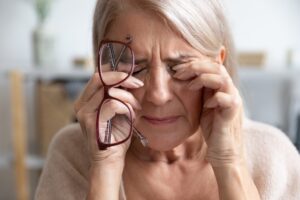What Vision Problems Should I Worry About as I Get Older?
 Aging can affect our eyes in various ways – from trouble seeing up close and discerning colors to cloudy or blurred vision and more severe ocular diseases. With advancements in optometry, early detection can often be a primary factor in preserving eye health and preventing more serious problems. Our Redding board-certified ophthalmologists and optometrists share which age-related eye problems are most common and explain how to properly care for unhealthy or changing vision.
Aging can affect our eyes in various ways – from trouble seeing up close and discerning colors to cloudy or blurred vision and more severe ocular diseases. With advancements in optometry, early detection can often be a primary factor in preserving eye health and preventing more serious problems. Our Redding board-certified ophthalmologists and optometrists share which age-related eye problems are most common and explain how to properly care for unhealthy or changing vision.
Cataracts
One of the most common eye conditions experienced as we get older — generally after age 65 — is cataracts, which develop from a buildup of protein in the eye’s natural lens, causing cloudy vision. The longer cataracts persist, the more detrimental it can be to your vision and may even lead to blindness. There are several different types of cataracts; however, “nuclear cataracts” are most often caused by the natural aging process and form around the center of the eye’s lens. It generally appears as a yellow or brown hue. Fortunately, this condition can be improved with cataract surgery to restore vision. The procedure is frequently covered or at least partially covered by most major insurance providers.
Macular Degeneration
Vision impairment from macular degeneration can affect patients as early as their 40s, beginning as mild blurriness or visual distortions. The condition is one of the leading causes of blindness in people over 50 years of age. Often referred to as Age-Related Macular Degeneration (AMD), this condition forms as the small spot close to the center of the retina due to the (macula) gradually breaking down, typically from genetics and/or environmental factors. The most common type of macular degeneration that tends to progress more slowly is non-neovascular (dry) when compared to neovascular (wet), which can cause severe visual impairment earlier on. Depending on the type and severity of the condition, macular degeneration can be treated with vitamin therapy, visual aids, or intravitreal injections.
Glaucoma
For our eyes to function properly, there needs to be a balance of fluid and drainage. When this process is interrupted and not draining properly, it can lead to increased fluid pressure on the optic nerve, resulting in eye damage – a condition known as glaucoma. Although more common after the age of 40, glaucoma may develop at any age. Unfortunately, symptoms often do not present themselves until reaching a more advanced stage, so regular eye check-ups and an early diagnosis are vital. If glaucoma is left untreated, it can lead to permanent eye damage, decreased vision, and blindness. Discovering this condition as soon as possible increases the chances for effective treatment with eye drops, lasers, implants, or surgery.
Presbyopia
As reading becomes harder to see at a close range, your eyes may have started to develop a condition called presbyopia. Generally, sight changes from presbyopia progress very slowly, but can begin as early as 35 years of age. In addition to trouble seeing smaller objects, presbyopia may cause eye fatigue and headaches. For most people, the use of reading glasses or multifocal (bifocal) lenses should be enough to improve vision and alleviate symptoms.
As recommended by the American Optometric Association (AOA), annual eye exams — especially if you are 60 years old or older — are a top priority. During these visits, it is best to share all medications you are taking as well as any health conditions, as certain conditions can affect your eyes and vision. For example, steroid-based medicines, diabetes, hypertension, and high blood pressure can all increase chances of having eye-related issues.
For more information about age-related vision problems, or to schedule a visit at Riverside EyeCare Professionals, please contact us today.